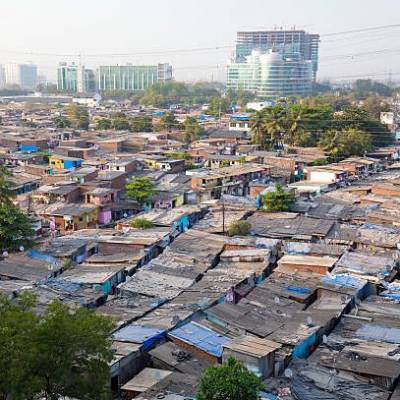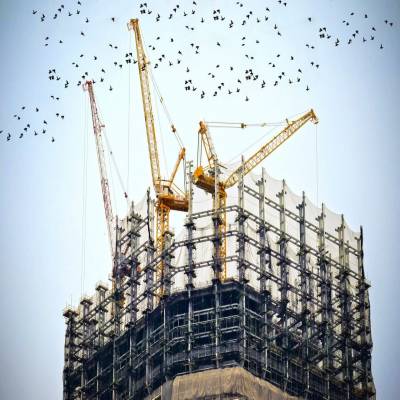- Home
- Real Estate
- Room to Expand

Room to Expand
In November 2016, the Indian Government announced the demonetisation of Rs 500 and Rs 1,000 currency notes. The impact of this move has been felt in the hospitality industry, where the peak season is from October to March. There has been a lull in the business, particularly in the unorganised sector and related small businesses. But the effect on the organised sector has been less pronounced as customers here are largely plastic money users.
´Over the short and medium terms, the demonetisation drive will have varied effects on the hospitality industry but, in the long term, it will have a positive impact on the growth of the sector, particularly the organised sector,´ avers Mandeep Lamba, Managing Director-Hotels & Hospitality, JLL India. ´However, as the larger base of hotel rooms is in the unorganised sector, we anticipate the general performance of the industry to witness some stress in the short term.
With banks flush with liquidity, we expect a major reduction in interest costs. As more liquidity enters the organised sector along with some softening of land rates and gradual movement towards cleaner real-estate transactions, we anticipate investments to increase from the organised players who have, in the past, shied away owing to complexities associated with underlying real estate.´
Anshu Sarin, CEO, Berggruen Hotels, seconds this, saying, ´Demonetisation will surely have short-term inconveniences but in the long term it will be beneficial for the sector.´
Berggruen runs 26 hotels across India under the brand name Keys in the premium, business and economy segments.
Supply and demand
The hotel industry, no doubt, needs all the impetus it can get to bridge the wide gap between supply and demand in hotel rooms. More so, as growth of supply has been declining since 2012 for various reasons, including the global economic downturn. ´From 2009 to 2015, hotel supply increased at an average of 5.8 per cent, with 2011 witnessing the period´s largest increase of 7.8 per cent,´ explains Lamba.
´However, from 2012 onwards, growth has been steadily declining, reaching a low of 3.9 per cent in 2015. We anticipate the declining trend to continue, with supply growth declining to 2.3 per cent by 2019, when the top 11 markets in India are expected to have a total room supply of nearly 150,000.´
The supply-demand gap has opened up huge opportunities for the hospitality and real-estate industries. Several real-estate developers are investing in this sector to leverage the opportunity. The Indian Government, too, has taken various measures like allowing 100 per cent FDI through the automatic route, capital subsidy programmes for budget hotels, and five-year income tax holidays for two to four-star hotels developed in UNESCO-declared World Heritage Sites.
The trends
Mixed land usage, MICE (meetings, incentive, conventions and exhibitions), service apartments, wildlife resorts, development of midmarket and budget hotels and online bookings are some of the emerging trends in the industry.
´A larger number of bookings will take place online as is the practice in more mature global markets,´ predicts Pradeep Kalra, Senior Vice President-Sales & Marketing, Sarovar Hotels, which has over 71 operational hotels across India in the three, four and five-star segments. ´Domestic travellers will continue to be the bedrock of demand. The MICE business in collaboration with short-stay business travel will drive demand. New and unexplored leisure destinations will open up as the young and trendy look for uncommon experiences. F&B offerings will play a crucial role in leisure destinations, as consumers travel more and gain more awareness.´
Going green with improved water and energy conservation services is also gaining momentum. ´The concept of green hotels is not new in India,´ points out Rattan Keswani, Deputy Managing Director, Lemon Tree Hotels, which operates 40 hotels across India in the upscale, midscale and economy segments. ´Most hotels are working towards complying with green building standards.
At Lemon Tree, all our existing and upcoming hotels qualify as LEED Gold equivalent buildings. In future, we plan to focus on wind power, geo thermal energy and agro power in our hotels in select locations.´
Innovative designs, international standards coupled with local flavour and modern construction technologies are some of the ingredients that shape architecture and design trends.
´Design and architecture in India stay true to local attributes, creating a USP in visuals and revolving around a personalised approach,´ shares Shekhar Bhargava, Executive Director, Royal Orchid Hotels. ´International brands, on the other hand, tend to rely on consistency and brand standards to ensure that wherever the guests travel, they recognise the similarities in the building façade and placement of the amenities and facilities in the hotel.´ Royal Orchid operates 37 hotels across India in the budget, business and luxury segments.
´There is a reduction in the number of heritage style designs. Owners are looking for more efficient floor plans. Designs also cater to optimising the costs by reducing the amount of glass in the façade,´ avers Arindam Mukherjee, COO, Brigade Group. ´There is an increase in the use of factory finished goods with a considerable reduction in on-site mill work. Usage of Building Information Modelling to reduce design interventions on site and to ensure minimal disruption to construction, system formwork to hasten the shell and core process, use of modular structures in some cases, are all gaining ground.´ Brigade has developed three hotels in India, which are operational, and seven are under various stages of construction.
The opportunities
About a decade ago, there were only a handful of hotel markets in India, namely the four metros, and cities like Bengaluru and Goa. In the past decade, with real-estate prices soaring and the cost of developing and sustaining business operations in these cities becoming prohibitive, investors began looking at other cities like Hyderabad, Pune, Jaipur, Gurgaon and Ahmedabad. Now, the focus is moving to Tier-II and Tier-III cities, aver industry pundits.
´A number of Tier-II and Tier-III cities are successful centres of economic growth,´ explains Sarin. ´The government has brought many of these cities under its Smart Cities mission. In coming years, these cities will emerge as attractive destinations for the hotel industry because of government investments in connectivity and technology infrastructure.´ Berggruen has recently launched new hotels in Tier-II markets, such as Visakhapatnam, Calicut and Jaipur.
Several domestic and international hotel brands are now aggressively focusing on their expansion strategies, particularly in the budget and midmarket segment, which has huge potential. Indian Railways has also entered the market with plans to set up 100 budget hotels at various stations along with private hospitality players. Medical tourism, eco-tourism and wedding tourism have also opened up new opportunities.
The challenges
While the opportunities are immense, there are also associated challenges like poor infrastructure, exorbitant land cost, multiple licences, complex approval procedures, long development cycle, cost overrun and liquidity constraints.
´The biggest challenge is land availability at reasonable costs that would make hotel development viable on borrowed funds,´ elaborates Kalra. ´Other major challenges include slow pace of infrastructure development, lack of skilled manpower especially in smaller towns, rigid regulatory environment and inadequate connectivity. These factors have a negative impact on the development of hotels in Tier-II and Tier-III markets. Strong emphasis must be laid on the development of more international airports, better rail and road networks, easing of procedures for obtaining licenses and permissions, and development of new geographies to augment tourist flow to hotels.´
Lamba concurs, saying, ´Our largest barrier continues to be the extreme regulatory environment that requires around 100 to 150 sanctions and permissions along with lending norms making the cost of capital extremely high. Reduced regulatory requirements and classification of the hospitality sector under infrastructure lending will give the industry a much-needed shot in the arm.´
Developmental costs are another challenge with the land cost accounting for 30-50 per cent of total development cost. According to reliable sources, setting up a five-star deluxe hotel with 250-300 rooms would cost about Rs 300 crore, excluding land cost. ´The cost of development for all categories of hotels is high in India, as is the cost of finance compared to the rest of the world,´ reveals Keswani. ´The cost of FSI is much higher. Cost of land internationally is 20 per cent of the project cost, while in India it is over 40 per cent. Globally, interest costs are half compared to India.´
Development costs have increased approximately 7-10 per cent per annum with the rate of inflation, says Mukherjee as he provides a cost indication: ´The cost of developing a hotel depends on several factors such as land, public areas, location, nature of the product (resort or business hotel) and various site constraints. However, for an approximation, the following costs per key (per room) can be considered: Luxury-Rs 1.5 crore onwards; upper upscale-Rs 70-80 lakh onwards; mid-market-Rs 50-60 lakh onwards; economy-Rs 30-40 lakh; budget-Rs 20-25 lakh. This is only the construction cost and does not include land cost.´
In fact, the hospitality sector has long been voicing the need for infrastructure status, effective single-window clearances, rationalisation of the number of tax levies and implementation of a single-tax regime. These hurdles aside, Indian hospitality is evidently poised for rapid growth. The possibilities are immense and an earnest effort, both from the industry´s key stakeholders and the relevant government bodies, will pave the way for progress.
Quick Bytes
- Emerging trends: Mixed land usage, MICE, service apartments, wildlife resorts, development of midmarket and budget hotels and online bookings.
- Domestic and international hotel brands are aggressively focusing on expanding to the budget and mid-market segments.
- Need of the hour: Infra status, effective single-window clearances, rationalisation of the number of tax levies and implementation of a single-tax regime.
Ongoing and in-the-pipeline projects
Royal Orchid: Projects under development in Dehradun, Varanasi and Srinagar. Sarovar Hotels: Projects lined up for completion in 2017 in Kapashera, Jaisalmer, Ranchi, Raipur, Amritsar, Jalandhar, Greater Noida, Junagadh, Gorakhpur, Bekal, Dalhousie, Ajmer and Rishikesh.
Berggruen Hotels: One project in Port Blair opening in early 2017. Lemon Tree Hotels: By the end of FY2017, opening an all-suites hotel in Noida, a 500-room twin property in Gurgaon, a Red Fox Hotel in Bhiwadi and two managed hotels in Siliguri and Sikkim. Also has many owned hotels under development in Kolkata, Mumbai, Pune, Udaipur and Shimla as well as managed hotels in Aligarh, Lucknow, Jammu, Coimbatore and Thiruvananthapuram.
Brigade Group: Projects under construction: Holiday Inn, Chennai; 3 Holiday Inn Express at different sites in Bengaluru; Four Points by Sheraton Kochi; two mid-market hotels in Mysuru and Ahmedabad.
Hospitality Hard Facts
The Indian hospitality industry, currently valued at Rs 309,110 crore, is projected to grow at a CAGR of 10 per cent by 2021.
After China, India is considered one of the most lucrative hotel markets in the world.
Maximum investments are expected to take place in Tier-I towns, followed by Tier-II towns.
The budget and midmarket segments have emerged as the most preferred investment categories.
Important hotels built during British India: The Rugby, Matheran (1876), The Taj Mahal Hotel, Mumbai (1900),The Grand, Calcutta (1930), The Cecil Hotels, Shimla and Muree (1935), The Savoy, Mussoorie (1936).
- JANAKI KRISHNAMOORTHI
To share your views on this article, write in at feedback@ConstructionWorld.in
- Demonetisation
- Mandeep Lamba
- JLL India
- Anshu Sarin
- Berggruen Hotels
- FDI
- UNESCO
- Real-estate developers
- Pradeep Kalra
- Sarovar Hotels
- Rattan Keswani
- Lemon Tree Hotels
- LEED Gold equivalent buildings
- Shekhar Bhargava
- Royal Orchid Hotels
- Arindam Mukherjee
- Brigade Group
- Tier-II
- Tier-III
- Hospitality sector
- MICE
- CAGR
- JANAKI KRISHNAMOORTHI
Despite feeling the effect of demonetisation in the short term, the Indian hospitality sector is poised for progress. In November 2016, the Indian Government announced the demonetisation of Rs 500 and Rs 1,000 currency notes. The impact of this move has been felt in the hospitality industry, where the peak season is from October to March. There has been a lull in the business, particularly in the unorganised sector and related small businesses. But the effect on the organised sector has been less pronounced as customers here are largely plastic money users. ´Over the short and medium terms, the demonetisation drive will have varied effects on the hospitality industry but, in the long term, it will have a positive impact on the growth of the sector, particularly the organised sector,´ avers Mandeep Lamba, Managing Director-Hotels & Hospitality, JLL India. ´However, as the larger base of hotel rooms is in the unorganised sector, we anticipate the general performance of the industry to witness some stress in the short term. With banks flush with liquidity, we expect a major reduction in interest costs. As more liquidity enters the organised sector along with some softening of land rates and gradual movement towards cleaner real-estate transactions, we anticipate investments to increase from the organised players who have, in the past, shied away owing to complexities associated with underlying real estate.´ Anshu Sarin, CEO, Berggruen Hotels, seconds this, saying, ´Demonetisation will surely have short-term inconveniences but in the long term it will be beneficial for the sector.´ Berggruen runs 26 hotels across India under the brand name Keys in the premium, business and economy segments. Supply and demand The hotel industry, no doubt, needs all the impetus it can get to bridge the wide gap between supply and demand in hotel rooms. More so, as growth of supply has been declining since 2012 for various reasons, including the global economic downturn. ´From 2009 to 2015, hotel supply increased at an average of 5.8 per cent, with 2011 witnessing the period´s largest increase of 7.8 per cent,´ explains Lamba. ´However, from 2012 onwards, growth has been steadily declining, reaching a low of 3.9 per cent in 2015. We anticipate the declining trend to continue, with supply growth declining to 2.3 per cent by 2019, when the top 11 markets in India are expected to have a total room supply of nearly 150,000.´ The supply-demand gap has opened up huge opportunities for the hospitality and real-estate industries. Several real-estate developers are investing in this sector to leverage the opportunity. The Indian Government, too, has taken various measures like allowing 100 per cent FDI through the automatic route, capital subsidy programmes for budget hotels, and five-year income tax holidays for two to four-star hotels developed in UNESCO-declared World Heritage Sites. The trends Mixed land usage, MICE (meetings, incentive, conventions and exhibitions), service apartments, wildlife resorts, development of midmarket and budget hotels and online bookings are some of the emerging trends in the industry. ´A larger number of bookings will take place online as is the practice in more mature global markets,´ predicts Pradeep Kalra, Senior Vice President-Sales & Marketing, Sarovar Hotels, which has over 71 operational hotels across India in the three, four and five-star segments. ´Domestic travellers will continue to be the bedrock of demand. The MICE business in collaboration with short-stay business travel will drive demand. New and unexplored leisure destinations will open up as the young and trendy look for uncommon experiences. F&B offerings will play a crucial role in leisure destinations, as consumers travel more and gain more awareness.´ Going green with improved water and energy conservation services is also gaining momentum. ´The concept of green hotels is not new in India,´ points out Rattan Keswani, Deputy Managing Director, Lemon Tree Hotels, which operates 40 hotels across India in the upscale, midscale and economy segments. ´Most hotels are working towards complying with green building standards. At Lemon Tree, all our existing and upcoming hotels qualify as LEED Gold equivalent buildings. In future, we plan to focus on wind power, geo thermal energy and agro power in our hotels in select locations.´ Innovative designs, international standards coupled with local flavour and modern construction technologies are some of the ingredients that shape architecture and design trends. ´Design and architecture in India stay true to local attributes, creating a USP in visuals and revolving around a personalised approach,´ shares Shekhar Bhargava, Executive Director, Royal Orchid Hotels. ´International brands, on the other hand, tend to rely on consistency and brand standards to ensure that wherever the guests travel, they recognise the similarities in the building façade and placement of the amenities and facilities in the hotel.´ Royal Orchid operates 37 hotels across India in the budget, business and luxury segments. ´There is a reduction in the number of heritage style designs. Owners are looking for more efficient floor plans. Designs also cater to optimising the costs by reducing the amount of glass in the façade,´ avers Arindam Mukherjee, COO, Brigade Group. ´There is an increase in the use of factory finished goods with a considerable reduction in on-site mill work. Usage of Building Information Modelling to reduce design interventions on site and to ensure minimal disruption to construction, system formwork to hasten the shell and core process, use of modular structures in some cases, are all gaining ground.´ Brigade has developed three hotels in India, which are operational, and seven are under various stages of construction. The opportunities About a decade ago, there were only a handful of hotel markets in India, namely the four metros, and cities like Bengaluru and Goa. In the past decade, with real-estate prices soaring and the cost of developing and sustaining business operations in these cities becoming prohibitive, investors began looking at other cities like Hyderabad, Pune, Jaipur, Gurgaon and Ahmedabad. Now, the focus is moving to Tier-II and Tier-III cities, aver industry pundits. ´A number of Tier-II and Tier-III cities are successful centres of economic growth,´ explains Sarin. ´The government has brought many of these cities under its Smart Cities mission. In coming years, these cities will emerge as attractive destinations for the hotel industry because of government investments in connectivity and technology infrastructure.´ Berggruen has recently launched new hotels in Tier-II markets, such as Visakhapatnam, Calicut and Jaipur. Several domestic and international hotel brands are now aggressively focusing on their expansion strategies, particularly in the budget and midmarket segment, which has huge potential. Indian Railways has also entered the market with plans to set up 100 budget hotels at various stations along with private hospitality players. Medical tourism, eco-tourism and wedding tourism have also opened up new opportunities. The challenges While the opportunities are immense, there are also associated challenges like poor infrastructure, exorbitant land cost, multiple licences, complex approval procedures, long development cycle, cost overrun and liquidity constraints. ´The biggest challenge is land availability at reasonable costs that would make hotel development viable on borrowed funds,´ elaborates Kalra. ´Other major challenges include slow pace of infrastructure development, lack of skilled manpower especially in smaller towns, rigid regulatory environment and inadequate connectivity. These factors have a negative impact on the development of hotels in Tier-II and Tier-III markets. Strong emphasis must be laid on the development of more international airports, better rail and road networks, easing of procedures for obtaining licenses and permissions, and development of new geographies to augment tourist flow to hotels.´ Lamba concurs, saying, ´Our largest barrier continues to be the extreme regulatory environment that requires around 100 to 150 sanctions and permissions along with lending norms making the cost of capital extremely high. Reduced regulatory requirements and classification of the hospitality sector under infrastructure lending will give the industry a much-needed shot in the arm.´ Developmental costs are another challenge with the land cost accounting for 30-50 per cent of total development cost. According to reliable sources, setting up a five-star deluxe hotel with 250-300 rooms would cost about Rs 300 crore, excluding land cost. ´The cost of development for all categories of hotels is high in India, as is the cost of finance compared to the rest of the world,´ reveals Keswani. ´The cost of FSI is much higher. Cost of land internationally is 20 per cent of the project cost, while in India it is over 40 per cent. Globally, interest costs are half compared to India.´ Development costs have increased approximately 7-10 per cent per annum with the rate of inflation, says Mukherjee as he provides a cost indication: ´The cost of developing a hotel depends on several factors such as land, public areas, location, nature of the product (resort or business hotel) and various site constraints. However, for an approximation, the following costs per key (per room) can be considered: Luxury-Rs 1.5 crore onwards; upper upscale-Rs 70-80 lakh onwards; mid-market-Rs 50-60 lakh onwards; economy-Rs 30-40 lakh; budget-Rs 20-25 lakh. This is only the construction cost and does not include land cost.´ In fact, the hospitality sector has long been voicing the need for infrastructure status, effective single-window clearances, rationalisation of the number of tax levies and implementation of a single-tax regime. These hurdles aside, Indian hospitality is evidently poised for rapid growth. The possibilities are immense and an earnest effort, both from the industry´s key stakeholders and the relevant government bodies, will pave the way for progress. Quick Bytes Emerging trends: Mixed land usage, MICE, service apartments, wildlife resorts, development of midmarket and budget hotels and online bookings. Domestic and international hotel brands are aggressively focusing on expanding to the budget and mid-market segments. Need of the hour: Infra status, effective single-window clearances, rationalisation of the number of tax levies and implementation of a single-tax regime. Ongoing and in-the-pipeline projects Royal Orchid: Projects under development in Dehradun, Varanasi and Srinagar. Sarovar Hotels: Projects lined up for completion in 2017 in Kapashera, Jaisalmer, Ranchi, Raipur, Amritsar, Jalandhar, Greater Noida, Junagadh, Gorakhpur, Bekal, Dalhousie, Ajmer and Rishikesh. Berggruen Hotels: One project in Port Blair opening in early 2017. Lemon Tree Hotels: By the end of FY2017, opening an all-suites hotel in Noida, a 500-room twin property in Gurgaon, a Red Fox Hotel in Bhiwadi and two managed hotels in Siliguri and Sikkim. Also has many owned hotels under development in Kolkata, Mumbai, Pune, Udaipur and Shimla as well as managed hotels in Aligarh, Lucknow, Jammu, Coimbatore and Thiruvananthapuram. Brigade Group: Projects under construction: Holiday Inn, Chennai; 3 Holiday Inn Express at different sites in Bengaluru; Four Points by Sheraton Kochi; two mid-market hotels in Mysuru and Ahmedabad. Hospitality Hard Facts The Indian hospitality industry, currently valued at Rs 309,110 crore, is projected to grow at a CAGR of 10 per cent by 2021. After China, India is considered one of the most lucrative hotel markets in the world. Maximum investments are expected to take place in Tier-I towns, followed by Tier-II towns. The budget and midmarket segments have emerged as the most preferred investment categories. Important hotels built during British India: The Rugby, Matheran (1876), The Taj Mahal Hotel, Mumbai (1900),The Grand, Calcutta (1930), The Cecil Hotels, Shimla and Muree (1935), The Savoy, Mussoorie (1936). - JANAKI KRISHNAMOORTHI To share your views on this article, write in at feedback@ConstructionWorld.in
























